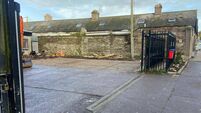Disease keeping bird’s numbers low
At least two pairs have been regular visitors to the peanut feeder outside my kitchen window.
This is good news because greenfinches had virtually vanished from the garden in recent years.
It was a nationwide decline caused by a disease called trichomoniasis (sometimes written as trichomonosis). It only affects birds and previously was just known in doves, pigeons and some birds of prey. But in 2005 it started to affect greenfinches in Britain. It spread to Ireland shortly afterwards and last September was reported in continental Europe.
It reduced the British population of greenfinches by about one third. The Irish Garden Bird Survey indicates a similar decline here. In Britain it has also been recorded in chaffinches and house sparrows. It reduced the British chaffinch population by about one fifth.
It’s caused by a minute parasite that lodges in the bird’s throat. This leads to a swelling that prevents the bird from swallowing food. The cause of death is starvation and dehydration.
Outbreaks normally occur in late summer and autumn. The initial infection is probably earlier in the year, during the breeding season.
Parents can infect their young when they’re feeding them and many bird species offer food as a gift to a prospective mate as part of their courtship ritual.
The parasite can also be passed through contaminated food or drinking water.
If you suspect that there is an outbreak in your area stop putting out food and water for the birds in your garden and sterilise all feeders and bird baths before they are used again.
There is no veterinary treatment for infected birds.
But I’m curious to know whether the increase in greenfinches in my garden is an isolated incident or a sign that the disease has run its course all over the country.
So I’d like to hear from any readers who have noticed changes in the greenfinch populations in their area.
I was also pleased to see that the Irish Wildlife Trust is continuing its national newt survey.
The survey is largely carried out by volunteers and the IWT organises training days for them.
Eight of these days are coming up in the nest few weeks. They are held in parts of the country where there is the greatest dearth of information about the distribution of newts. These are Wexford, Mayo, Louth, Clare, Laois, Limerick, Kildare and Donegal.
The workshops are free to IWT members, with a modest fee of €20 for non-members.
If you have a little spare time and live in one of these counties I would thoroughly recommend this, even if you’ve never taken part in a wildlife survey before. Compared to song-birds or small mammals, newts are very easy to recognise.
There’s only one species in Ireland, the smooth newt, and there’s nothing you can confuse them with, except possibly lizards.
By the time the survey takes place it will be the breeding season for newts so they’ll be in the water and lizards will be on dry land.
Going down to your local pond to search for newts could also be an ideal family activity.
Kids are fascinated by them because they look like little dinosaurs or dragons. The males are impressive in the breeding season when they develop an undulating crest along their backs, their bellies turn orange and there are conspicuous spots on their flanks and throats. More information at www.iwt.ie
* dick.warner@examiner.ie














